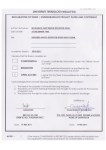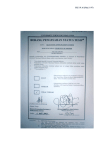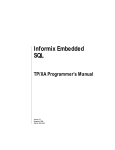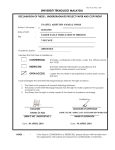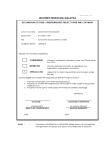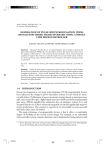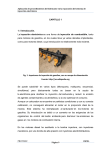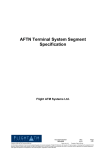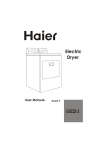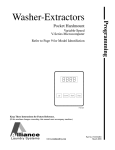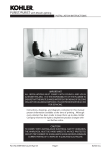Download inventory security system for institution of higher
Transcript
INVENTORY SECURITY SYSTEM FOR INSTITUTION OF HIGHER LEARNING NOR ANIZA MAULAD MOHD YUSOF UNIVERSITI TEKNOLOGI MALAYSIA “I hereby declare that I have read this thesis and in my opinion this thesis is sufficient in terms of scope and quality for the award of the degree of Electrical Engineering (Telecommunication)” Signature : .................................................... Name of Supervisor : Assoc. Prof. Dr. Sevia M. Idrus Date : 23 April 2010 INVENTORY SECURITY SYSTEM FOR INSTITUTION OF HIGHER LEARNING NOR ANIZA MAULAD MOHD YUSOF This thesis submitted in fulfilment of the requirements for the award of the degree of Bachelor of Engineering (Electrical-Telecommunication) Faculty of Electrical Engineering Universiti Teknologi Malaysia MAY 2010 ii I declare that this thesis entitled “Inventory Security System for Institution of Higher Learning” is the result of my own research except as cited in the references. The thesis has not been accepted for any degree and is not concurrently submitted in candidature of any other degree. Signature : .................................................... Name : Nor Aniza Maulad Mohd Yusof Date : 23 April 2010 iii To my beloved mother and father Mohd Yusof Hashim & Faridah Abas Brother and sisters iv ACKNOWLEDGEMENT First of all, all praise to Allah, the Almighty, the Benevolent for His blessings and guidance for giving me the inspiration to embark on this journey and inculcating patience in my heart to complete this project which has nurtured me with all the necessary qualities of honesty, integrity, responsibility and the value of time. I am greatly and profoundly thankful to my supervisor, Assoc. Prof Dr Sevia M. Idrus for facilitating me with this opportunity and also her constant comments, assistance, guidance and advice all this time while maintaining her inspection on my progression. I am indebted to Siti Marwangi, Afifah Taat, Mohd Fenddizulkarnain and to all my friends for their information sharing and spirit of companionship from the beginning of the project until the last of it. Also, I wish to express my sincere thanks to those people that I don’t mentioned here, who extended their help during the course of my final year project work. Further the acknowledgement would be incomplete if I would not mention a word of thanks to my most beloved parents whose continuous support and encouragement all the way through the course has led me to pursue the degree and confidently complete the project. Last but not least, I hope that my project thesis will give good benefits to Universiti Teknologi Malaysia. v ABSTRACT Advances in electronics, wireless communications, and global positioning devices, have led to impressive developments in various tracking and tagging devices. In the case of inventory tagging, Radio Frequency Identification Device (RFID) is widely used to aid in its identification and tracking via radio waves. Therefore, the security product developed particularly designed for Institution of Higher Learning (IHL), by some means this design will increase the performance of security operation and also improving the efficiency in updating inventory database. The design was tested to examine the workability between the RFID tag with the reader and updating the inventory database. This project has fulfilled the objectives as the system is performing well as desired and successfully implemented in several scenarios. The originality and innovativeness of this design contributes to effective and efficient way in updating together with securing the inventory properties. vi ABSTRAK Kemajuan dalam eletronik, telekomunikasi tanpa wayar, dan kedudukan kemudahan telah membawa kepada pembangunan yang memberangsangkan dalam pelbagai peralatan untuk mengesan dan melabel. Dari segi melabel inventori, Radio Frequency Identifiction (RFID) telah digunakan secara meluas terutama sekali bagi tujuan pengenalan dan mengesan melalui gelombang radio. Oleh itu, satu sistem keselamatan dibangunkan untuk Institut Pengajian Tinggi dimana sistem ini mampu menambahbaikkan prestasi operasi keselamatan dan juga kecekapan dalam pengemaskinian pangkalan data. Sistem ini telah diuji untuk menentukan kebolehkerjaannya dan projek ini telah berjaya mencapai objektif dimana sistem ini beroperasi dengan baik dalam berbagai senario seperti yang dirancang. Ketulenan dan keinovatifan sistem ini mampu menyumbang kepada kecekapan dan keberkesanan dalam mengemaskini data serta melindungi inventori pada masa yang sama. vii TABLE OF CONTENTS CHAPTER 1 TITLE PAGE DECLARATION ii DEDICATION iii ACKNOWLEDGEMENTS iv ABSTRACT v ABSTRAK vi TABLE OF CONTENTS vii LIST OF TABLES x LIST OF FIGURES xi LIST OF ABBREVIATIONS xii LIST OF SYMBOLS xiii INTRODUCTION 1.1 Introduction 1 1.2 Problem Statement 2 1.3 Market Survey 3 1.4 Project Background 3 1.5 Project Objectives 4 1.6 Scope of Project 4 1.7 Research Background 5 1.8 Project Outline 6 1.9 Summary 6 viii 2 3 4 LITERATURE REVIEW 2.1 Introduction 8 2.2 Radio Frequency Identification 9 2.2.1 RFID Tag 10 2.2.2 RFID Reader 12 2.3 Graphical User Interface 14 2.4 Summary 15 METHODOLOGY AND SYSTEM DESIGN 3.1 Introduction 16 3.2 Methodology 17 3.3 Product Description 17 3.3.1 18 Inventory Security Display System 3.3.2 Inventory Monitoring System 19 3.4 System Interaction 22 3.5 System Flow Chart 23 3.6 System Block Diagram 24 3.7 Component and Subsystem 25 3.8 Summary 26 PROTOTYPE DEVELOPMENT 4.1 Introduction 27 4.2 Hardware 27 4.2.1 28 Passive RFID Tag 4.2.2 Passive RFID Reader 28 4.2.3 USB Webcam 30 4.2.4 Hardware Configuration 31 4.2.5 Hardware Connection 32 4.3 Software 33 4.4 Database 35 4.5 System Implementation 36 4.6 Summary 37 ix 5 CONCLUSION 5.1 Problems and Recommendation 38 5.2 Commercial Potential 39 5.3 Future Work Recommendation 39 5.4 Conclusion 40 REFERENCES 41 APPENDIX A 42 Source Code for Software Programming APPENDIX B 47 Passive RFID Reader Type IDR-232 Manual APPENDIX C 54 FKE’s Database Layout APPENDIX D Document Pattern APPENDIX C Novelty and Pattern Report APPENDIX D Control Panel Layout 57 x LIST OF TABLES TABLE NO. 2.1 TITLE The range for popular use of RFID frequency PAGE 13 1 xi LIST OF FIGURES FIGURE NO. TITLE PAGE 3.1 Example of Inventory portal system 18 3.2 Lecture Hall 19 3.3 RFID system 20 3.4 UTM Guard House 21 3.5 UTM Security officers 21 3.6 System Interaction between components 22 3.7 System Flow Chart 23 3.8 Inventory Security System Block Diagram 24 4.1 Passive RFID Keychain Tag 28 4.2 Passive RFID Reader type IDR-232 29 4.3 USB Webcam 29 4.4 Male PS2 pin configuration 30 4.5 Female DB9 pin configuration 30 4.6 COM connections setting 31 4.7 IDR-232 Reader Configurations 32 4.8 USB Converter 33 4.9 Programming Writing Development 33 4.10 System’s Graphical User Interface 34 4.11 FKE Inventory Database 35 4.12 Real System Implementation 36 4.13 USB Webcam interface 37 xii2 LIST OF ABBREVIATIONS RFID - Radio Frequency Identification USB - Universal Serial Bus RF - Radio Frequency LAN - Local Area Network IS - Inventory Security VLF - Very Low Frequency EHF - Extremely High Frequency VB - Visual Basic LED - Light Emitting Diode PC - Personal Computer CCTV - Closed-circuit Television ID - Identification FKE - Faculty of Electrical Engineering LAN - Local Area Network GH - Guard House PIC - Peripheral Interface Controller LCD - Liquid Crystal Display LOS - Line of Sight SMS - Short Message Service xiii3 LIST OF SYMBOLS Hz - Hertz V - Volt M - Meter Cm - Centimetre 1 CHAPTER 1 INTRODUCTION 1.1 Introduction Nowadays, a system for tracking and tagging by using the RFID technology are widely used since the RFID tag have been broadly commercialize especially in shopping complex. One of the major benefits by utilizing RFID tag technology such that the system does not involved complex circuit and the RFID tag is also inexpensive. Moreover, RFID tag can be designed in variety of size that makes it more flexible, which the size of the tag depend on the purpose of the usage. Moreover, RFID are also commonly used for identification and monitoring purposes. Therefore, it is beneficial if we redesign the already invented product in order to improve the Inventory Security (IS) system for IHL. This security product developed for IHL, by some means to improve the performance of security system performance. The product do offer number of features by using Graphical User Interface (GUI) application such mechanical force detection, movement detection and distance range acknowledgement from control panel together with other basic feature like alarm system. 2 1.2 Problem Statement As we already acknowledge, IHL or also known as university, commonly contain numbers of valuable technology, and expensive inventories. All this inventories or properties not just cover an electrical appliance, but do the furnishings as well. Normally, the basic appliance stored inside each lecture hall and classroom consists of a set of multiple tables-chairs, white board, projector, white screen projector display, computer, microphones and other basic furnishing and electrical equipments. These all inventories somewhere are not really in safe and secured protected. This indirectly will lead to the low security level toward all the inventories. Most of the IHL in Malaysia use the automatic door lock system as their main protection toward those inventories. This system eventually will lead to several consequences that might be occurred due to this lack of low security level. The consequences are such that it will lead to the increasing number of missing inventories and perhaps, not workable inventories especially electrical equipments such as projector, computer, microphone, and etc. In fact, this automatic door lock system method is not fully protecting the inventories especially during lecture hour, since the door is not locked by the last person out from the room. The large number of inventories makes it almost impossible to record and update manually. At the end of the year, all the inventories are not completely update. And one of the factors that contribute to this problem is that the inventories information are not completely recorded and most of the case, the missing inventories go unnoticed in many occasions. 3 1.3 Market survey In order to support the developing of the project, a field work of survey have being constructed and being distributed to several expected user such a maintenance department and security officers. Majorities the expected user gave a good feedback and encouraged that the system should be develop for an IHL. Hence, there are three reasons why the product is beneficial and different with other implemented system that already in the market: 1. This IS systems enhanced with GUI Device and RFID technology offered by Inventory Security system are the first design system which offers an effective and efficient way in monitoring together with securing the inventory properties. 2. Improving IHL security system especially preventing the inventories from irresponsible person. 3. The IS system will increase the workability performance of maintenance staff, hence indirectly controlling the inventories stockin/stock-out activities. 1.4 Project Background IS system is basically a security monitoring system for IHL. This product will increase the performance and the efficient of security system that have been invented before. The system offered 24-hour inventory security monitoring by GUI Device that connected with the control panel. In addition, the consumption of energy or manpower would be reduced, since the system made for the maintenance staff to monitoring the inventories at faculties or departments more effectively and in efficient way. In fact, this active RFID Tag will assure that the inventories are in secure condition. The develop system are practical, effective and time-saving, hence, 4 the product is marketable for commercial purposes; acquisition of the system by the maintenance management will increase the inventory security effectiveness. 1.5 Project Objectives Several objectives are set in the early stage of this project. It is to ensure that all purpose of the project can be achieved after completing the project. 1. To develop a security system for IHL inventory by using RFID systems and GUI device. 2. To improve the IHL security system especially preventing the inventories from irresponsible people. 1.6 Scope of Project This project basically concern on communication between RFID tags and RFID sensor with the control panel. On top of that, the critical part of this project was writing a programming by using Microsoft Visual Basic 6.0 (VB) software for the GUI device monitoring software and other programming for the control panel can be interface with the other subsystem. Last but not least, analyzing the possible circuit involved in order to develop and complete the product. 5 1.7 Research Background Start with the RFID Technology; basically, there are two general types of RFID systems that can be installed: a closed-loop system or an open-looped system. Closed-loop systems generally have little or no contact with the outside world. Everything is done within one facility or organization and therefore can have their own standards set by the organization. While an open-loop system has information that will be shared with outside vendors and/or customers. This could involve tracking containers, monitoring rental cars leaving and returning a location, point-of-sale applications, or baggage handling. The reason open systems are rarely used today is due to the lack of a standard and central database. The potential an open-loop system brings is tremendous. Being able to track a pallet all the way through the supply chain, or being able to locate a single item anywhere in your warehouse, or even your client’s warehouse, has tremendous implications. Unfortunately, a standard needs to be set that is adopted across the board before an open-loop system’s potential can be unleashed. Other than RFID technology, a GUI application can be develop by using Visual Basic, JAVA, Pascal, C programming and C++ programming. This VB is actually similar to programming language, but VB was designed to be easily learned and user by the beginner programmers. Moreover, GUI is mainly an acronym for "graphical user interface", such as Mac OS, Mac OS X, Microsoft Windows, and the X Window System. A GUI lets you interact with your computer using pictures and symbols, rather than having to memorize many complicated commands and type them precisely, as with a command-line interface such as DOS. Most computer users today become familiar with using GUIs before using any other type of interface. 6 1.8 Project Outline This Project Report is organized in 5 chapters. The first chapter gives an overview of the whole project. Start with the introduction of RFID and roughly on the product description. Chapter Two covers literature review on RFID technology including RFID tag, RFID reader, software involved which is VB 6.0. Chapter Three covers the methodology and system design used towards developing the product. And also product system operation that consists of system flow chart and block diagram. Chapter Four is focusing on prototype development. It is involves programming, software development and circuit analyzing of this project. Chapter Five which is the last chapter, are the conclusion part for the whole project also includes suggestion for further enhancement and recommendation for future development of this project. Lastly, comprise conclusion of the Project. 1.9 Summary As a conclusion of the first chapter, RFID comprise of open-loop and closedloop system. The security level toward the inventories can be increase by using a RFID tag that being attached to all the inventories. Moreover, with the help of GUI 7 application, all the inventories can be monitored 24-hour. Manipulation the application of RFID technology can lead to the developing of the new product that has not been implemented before. It lies on our creativity to redesign and added extra number of features so that the new product will be beneficial to expected client. 8 CHAPTER 2 LITERATURE REVIEW 2.1 Introduction RF technology is used in many different applications, such as television, radio, cellular phones, radar, and automatic identification systems. The term RFID describes the use of radio frequency signals to provide automatic identification of items. The basic RFID technology comprise of three main system or component. These three are RFID tag, RFID reader and host computer. Other subsystem can be added depending on the purpose of the project and the function of each of it. A system for monitoring assets and personnel associated to IHL has not been implemented yet in Malaysia. The common and the latest security system that have being used for IHL is automatic door lock system, which require an authoritative to enter the pass-code in order to unlock the door. 9 Instead of using automatic door lock system, this monitoring system together with security system involve a materials tagging subsystem that comprising RFID tags placed on items of property or inventory, while RFID reader to communicate with the tag, and a control panel for storing the inventory data. 2.2 Radio Frequency Identification RF refers to electromagnetic waves that have a wavelength suited for use in radio communication. Radio waves are classified by their frequencies, which are expressed in kilohertz, megahertz, or gigahertz. Radio frequencies range from very low frequency (VLF), which has a range of 10 to 30 kHz, to extremely high frequency (EHF), which has a range of 30 to 300 GHz. RFID is a flexible technology that is convenient, easy to use, and well suited for automatic operation. It combines advantages not like other available identification technologies. RFID can be supplied as read-only or read / write, does not require contact or line-of-sight to operate, can function under a variety of environmental conditions, and provides a high level of data integrity. In addition, because the technology is difficult to counterfeit, RFID provides a high level of security. RFID is similar in concept to bar coding. Bar code systems use a reader and coded labels that are attached to an item, whereas RFID uses a reader and special RFID devices that are attached to an item. Bar code uses optical signals to transfer information from the label to the reader; RFID uses RF signals to transfer information from the RFID device to the reader. 10 Radio waves transfer data between an item to which an RFID device is attached and an RFID reader. The device can contain data about the item, such as what the item is, what time the device travelled through a certain zone, perhaps even a parameter such as distance and temperature. RFID devices, such as a tag or label, can be attached to virtually anything – from a vehicle to a pallet of merchandise. RFID technology uses frequencies within the range of 50 kHz to 2.5 GHz. An RFID system typically includes the following components: • An RFID device (transponder or tag) that contains data about an item • An antenna used to transmit the RF signals between the reader and the RFID device • An RF transceiver that generates the RF signals • A reader that receives RF transmissions from an RFID device and passes the data to a host system for processing. In addition to this basic RFID equipment, an RFID system includes application-specific software. 2.2.1 RFID Tag The RFID Tag basically classified in three categories; one is an active RFID tag that contains a battery. This tag is able to transmit various signals autonomously. Second RFID type is a passive RFID tag. It contains no battery and needs an external source in order to promote signal transmission. And the last type which the third type of RFID tag is a Battery Assisted Passive (BAP), this basically require an external source in order to wake up . It also has a higher forward link which is capable of offering decent read range. 11 Active RFID tags are well known today. An Active RFID tag includes a small battery, and transmits RF signals via an integral antenna. The battery adds significant cost to the active RFID tag. The Active RFID may be pre-programmed with an identity that represents the identity of the product which bears the RFID tag. The transmitted RF signals typically include the identity of the Active RFID tag. If the Active RFID tag includes data such as a recorded temperature, distance parameter or other relative information, the Active RFID tag may transmit the data as well. An Active RFID tags can effectively transmit to a receiver up to 100 meters away. Passive RFID tags are also well known today. A Passive RFID tag does not include a battery; instead, the Passive RFID tag has an integral antenna which receives RF signals from an Active RFID tag or remote transceiver. The transmitted RF signals power the Passive RFID tag, i.e. the Passive RFID tag captures the energy of the RF signals which it receives and uses the energy to drive transceiver and other circuitry on the Passive RFID tag. The transceiver circuitry on the Passive RFID tag transmits the identity coded into the Passive RFID to identify the product which bears the Passive RFID tag. The Passive RFID tag may also include a memory to store any type of information transmitted by the Active RFID tag or other remote transceiver. Typically, Passive RFID tags have a smaller range detection of about three meters. Other than those three types of RFID tags mentioned above, there another type of RFID; chip less RFID tag. A chipless RFID tag (also known as RF fibers) is one that does not make use of any integrated circuit technology to store information. The tag uses fibers or materials that reflect a portion of the reader's signal back and this unique return signal can be used as an identifier. The fibers are shaped in different ways; thin threads, fine wires or even labels or laminates. At volume, they range in cost from ten cents to twenty-five cents per unit. Chipless RFID tags can be used in many different environments than RFID tags with electronic circuitry. On top of that, this tag also is less sensitive to RF interference. Chipless tags are sometimes 12 used in anti-counterfeiting with documents. However, since the tags cannot transmit a unique serial number, they are less usable in the supply chain. For the purpose of this project, we only use an active RFID tagging. This is due to the advantages of an active RFID tag itself. Unlike passive RFID tags, active RFID tags have their own internal power source, which is used to power the integrated circuits and to broadcast the response signal to the reader. Communications from active tags to readers is typically much more reliable resulting in fewer errors than those from passive tags. In turn, active tags are generally bigger (due to battery size) and more expensive to manufacture (due to price of the battery). However, their potential shelf life is comparable, as self-discharge of batteries competes with corrosion of aluminates printed circuits. Many active tags today have operational ranges of hundreds of meters, and a battery life of up to 10 years. Active tags may include larger memories than passive tags, and may include the ability to store additional information received from the reader. 2.2.2 RFID Reader The reader is the one of the key element in the system it is responsible for initiating the operation of the system. The reader is a complete transponder, which implements all the important functions for the system. Basically, an RFID reader is similar to the barcode scanner system. A barcode scanner uses either a laser or imaging device to obtain information from a barcode. This information is then either interpreted by the reader or sent directly to a main computer to be interpreted and analyzed. An RFID reader does the same thing, only it uses low power radio waves to obtain information from the RFID tag. 13 On the other hand, readers can also program RFID tags. The RFID reader uses an antenna to send and receive signals to and from RFID tags. The antenna can be either an internal or an external addition. In fact, some barcode scanning devices can add an RFID detector/receiver on them to become a reader. Readers can also be fixed mounted; fixed mounted readers can be found at a receiving dock’s bay door or at a Smart Tag toll booth. A fixed reader creates a magnetic field which the tag passes through, allowing the reader to send and receive information. As the information is received by the device, it is processed by its internal computer or sent via your wired network, or wireless LAN system, back to your main database. This data is then processed as they normally would be by the main computer. Readers have to be able to read in the particular frequency for the tag that is currently used, and this is one of the challenges developer has to face with when installing an RFID system. The three most common frequencies used are low frequency, high frequency, and ultra-high frequency. Table 2.1 shows the frequency level and range. Table 2.1: The range for popular use of RFID frequency While readers and tags need to operate at the same frequency, there are several other attributes that they must have in common in order to be fully compatible; these attributes include encryption and decoding algorithms, data content and format, interface protocols, and other technical specifications. It a must to fully understand all of these attributes in order to ensure that the readers and tags will be able to interact. 14 In this project we use an active RFID reader that can only read the data from the RFID tag. The reader will take the data that have been sent by RFID tag and sent it to the computer through the serial cable. 2.3 Graphical User Interface In this project, VB 6.0 was used to implement the GUI application. The language in VB not only allows programmer to create simple GUI application, but can also develop complex applications. Programming in VB is a combination of visually arranging components or controls on a form, specifying attributes and actions of those components, and writing additional lines of code for more functionality. Since default attributes and actions are defined for the components, a simple program can be created without the programmer having to write many lines of code. Performance problems were experienced by earlier versions, but with faster computers and native code compilation this has become less of an issue. Forms are created using drag-and-drop techniques. A tool is used to place controls, such as text boxes, button and etc. Controls have attributes and event handlers associated with them. Default values are provided when the control is created, but may be changed by the programmer. Many attributes values can be modified during run time based on user actions or changes in the environment, providing a dynamic application. Other than that, VB can create executable (EXE files), ActiveX Controls, or DLL files, but its primarily used is to develop Windows application and to interface 15 database systems. Dialog boxes with less functionality can be used to provide pop-up capabilities. Controls provide the basic functionality of the application, while programmers can insert additional logic within the appropriate event handlers. 2.4 Summary At the end of this chapter, it can be concluded that there is various type of RFID tag in the market nowadays. All this type was design for assorted type of application. It’s depends on us as a user to choose the type. Other than that, RFID tag alone won’t be workable without RFID reader. The RFID tag must operate at the same frequency as RFID reader in order to communicate with each other. Meanwhile, GUI application also plays an important role as software for running an application. We as a designer have to determine what application we want to develop. 16 CHAPTER 3 METHODOLOGY AND SYSTEM DESIGN 3.1 Introduction Inventory security system utilizing RFID technology is one of the first design systems that make uses of the RFID tag for the monitoring and security purposes. In this project, all the RFID tag will be tag and attached to each inventories. This tag will work when the mechanical force detector is activated. Two types of RFID tag will be used to separate the types of inventory; electrical appliance and furnishing inventory. This chapter mainly discuss about the project methodology approach in order to developing this product, project description on the system process flow together with system block diagram and also the system operation. 17 3.2 Methodology An excellent project mainly supported by research methodology which is very important in guiding the works. The methodology begin with full understanding on the literature review on RFID application, GUI system and security system design collectively gaining creative ideas of the product features. Secondly is developing a systematic security system flow chart and software block diagram. Next approach is in designing the control system for the security system. During this approach, microcontroller working concept will be studied then proceed with the writing a programming security system. Later construct the hardware model involved, such as RFID tag, RFID reader, alarm system and other subsystems. Lastly, proceed with practical measurement and demonstration of the workable security inventory system. 3.3 Product Description The product is developed for maintenance staffs to have easier ways to monitor the inventory with much more convenience and have more efficient ways to find their missing inventory. With the used of unique RFID tag, the maintenance staff are capable in tracking, identifying and collecting the inventory data. Moreover, each RFID tag can be linked to a database that stored specific information about the inventory. If the maintenance management suspecting any missing inventory, the maintenance staffs are capable directly alerting the Guard house and all the information needed can be notify. 18 The product operation and function could be divided in two main control systems in general: 3.3.1 Inventory Security Display System The control system and operation system are located at the control panel room. In this case perhapas at faculties or department. This includes the server with GUI Device, inventory display board, security alert including lighting and sound alert, and other possible function for upgrading. However, the Closed-circuit Television (CCTV) system is not interface with our product, which the CCTV is optional for the management to identify the suspect in case something happen or as a reference. Guard House also be able to using this portal whenever needed. Figure 3.1 Example of Inventory portal system 19 3.3.2 Inventory Monitoring System The system operation in this design is for an IHL that have one main exit and three sub-exits. A minor modification is needed for each exit. The control system is located at the central of assign faculties or departments. i) First Scenario 1. The properties or the inventories location are as normal and in the region of control area. Nothing suspicious movement detected. 2. The maintenance staff can operate the control panel as normal. 3. All the inventories are in safe and secure condition. Figure 3.2 Lecture Hall 20 ii) Second Scenario 1. Mechanical force detection has detected a suspicious inventory movement, which the inventories are bringing out of the lecture rooms, offices or even laboratories. 2. The inventories are still in the region of control area. 3. As the inventories are moving out from the lecture hall, the mechanical force detector will alert the security system at the control room. 4. The security system will interconnect with GUI device to acknowledge the parameter and will display the inventories movement. 5. For purpose of precaution, the maintenance staff at the control panel will send the security alert to the security officers at the all Guard House (GH). 6. Thus, security officers will monitoring the suspected inventory and put it in standby alert. Figure 3.3 RFID system iii) Third Scenario 1. This scenario is considering that the inventories are still in the range of control area, but it is approaching the GH; any of four GH. 2. RFID sensor will be located at the range of 100 meter from GH. As the properties are pass through the sensor, the alert system will again notify all he GH. 3. At this state, the alert sound system will be turn ON, and the security officer will standby at the gate to identify and stop the suspected vehicle. 21 4. As the sound system become louder, it is indicate that the suspected vehicle is approaching closely to the gate. Thus, the security officer can easily identify and stop the suspected vehicle for further vehicle checking. 5. The alert system will automatic turned off as the security officers deactivate the RFID tag. Further acknowledgement will be sent to the maintenance control panel. Figure 3.4 UTM Guard House iv) Fourth Scenario 1. This scenario is after the suspected vehicle is being stop. 2. The security officers will keep the inventories for log report proceeding purpose. Figure 3.5 UTM Security officers 22 3.4 System Interaction The operation system comprises of control panel to control the operation, together with monitor all the tag and also will be design to make it user friendly. The software will be build by VB 6.0 Software. The software will detect the entire signal from RFID tag also from RFID reader. GUI system is an application that will interface with a computer and security system alert to detect any illegal activities with the help of mechanical force detector and alert system. This mechanical force detector will be attached together with the RFID Tag. Additionally, the alert system will interface with all four GH. The inputs of the systems are switch to turn on the system, and RFID tag that being tag at all the inventories. This active RFID tag will operate at same frequency as the reader. The outputs of the system include security system alert and GUI Device that will display the inventories parameter and the movement. In fact, this GUI Device will interconnect with all Guard House monitor. Besides that, additional RFID sensor will be located at all Guard House in the range of 100 meters away before exit. Figure 3.6 System Interaction between components. 23 3.5 System Flow Chart START I/P from maintenance Inventory monitoring activity YES 1st scenario NO NO nd 2 scenario YES Mechanical force detection YES Alert system ON GUI Device NO GH 1 GH 2 GH 3 3rd Scenario YES RFID Sensor NO 4rd Scenario YES Return to START Figure 3.7 System Flow Chart GH 4 24 3.6 System Block Diagram Control Panel RFID reader Access Control Server Software RFID tag place on inventories Microcontroller Security System Mechanical Force Detector RFID Sensor Alert system Sound LED GUI Device GH1 GH2 GH3 GH4 GH1 Figure 3.8 GH2 GH3 GH4 Inventory Security System Block Diagram 25 3.7 Component and Subsystem The component used for IS system are switch, motion detector, mechanical force detector, GUI device, RFID tag, alert circuit, PIC controller, LCD, battery power unit and electronic component circuit. 1. Switch A switch is used to open and close the electronic circuit of the whole system. Therefore, the system will operate when the switch is on. The OFF switch will inactivate the system. 2. Mechanical force Detector Mechanical force detector will be the input of this circuit system, where it detects the movement in a certain area to give a signal to the PLC controller. 3. PIC controller PLC controller has been programmed to control the functions of the security system. This includes getting a signal from GUI device, and the detector. The controllers will activate the security system by data that have been taken from input and activate the alert system by the program in the controller. 4. Electronic Display Board This security system is using several LCD to display the parameter and movement of the inventory. Each LCD will be located at each Guard House. 5. Electronic component circuit Overall circuit of IS system contain the main components that been stated before and also a few additional components and circuits such as LED circuit, LCD circuit, and the main circuit. 26 6. GUI device This circuit develop the interface of a hardware system with the computer where its control the IS system by monitoring it. The simple main circuit connected the controller with the computer. The software we are using to interface is the VB 6.0 software. 7. RFID tag/ RFID sensor All the inventories will be tagged by the active RFID tag. Each RFID readers will cover the surrounding area up to 100 meter radius. In this case, there are two different RFID tags are being used. One tag is for electrical equipments and another tag is specialized for furniture. RFID sensor will be located 100 meters away from all GH. 3.8 Summary The conclusion of this chapter will be the methodology approach and also project description as well as all the system operation involved. Moreover, the system block diagram and system flow chart were briefly explained. Last part of this chapter was list of component and subsystem that will be using in designing and constructing the product. 27 CHAPTER 4 PROTOTYPE DEVELOPMENT 4.1 Introduction This chapter will be focusing on software development which is programme writing and interfacing between the hardware with the software. Moreover, all the connection will be discussed in this chapter. 4.2 Hardware As a prototype of this project, two passive RFID tags and one passive RFID reader with communication medium of RS-232 cable and PS2 USB Converter were used. While for the medium interface between the hardware and the software, a personal laptop was used for that purpose. While the additional USB Webcam that has being used in this prototype was actually operated as a CCTV. 28 4.2.1 Passive RFID Tag Two passive RFID tag that have being used in this prototype is keychain passive RFID type. Both these passive RFID keychain tag come with a unique ID number, ID 0012367602 was ID for the first tag while for the second tag ID 0004090463. Moreover, both of these tag is energized by a time varying electromagnetic RF signal or also known as carrier signal. In this prototype, the standard frequency that being used was 125 kHz. Figure 4.1 Passive RFID Keychain Tag 4.2.2 Passive RFID Reader For the reader, Passive RFID Reader type IDR-232 was being used in this prototype that give maximum reading range up to 3cm. It has been proved by the Line of Sight (LOS) situation with and without obstacles. This plug and play RFID reader has been design with capabilities and features of integrated RFID reader, antenna, LED, power cable and data cable. In fact, it has buzzer as a sound indication of activity, faster response time which is 0.1s response time and operate in low operating frequency 125 kHz. IDR-232’s power source is from PS2 connection, thus no communication through PS2 connector, only 5V voltage supply taken from this connector that being 29 connected through PC or personal laptop. While for the communication line purpose, RS232 cable (serial port with female DB9) being used. Figure 4.2 Passive RFID Reader type IDR-232 Alternatively, reader modification and interface is necessary if not using any PC or personal laptop. PS2 will provide %V and ground to IDR-232, while female DB9 is communication line to PC or personal laptop. Below show the pin configuration of PS2 and DB9 of IDR-232. NA NA Gnd Vcc (5V) NA NA Figure 4.3 Male PS2 pin configuration 30 Gnd NA NA Figure 4.4 Rx NA Tx NA NA NA Female DB9 pin configuration 4.2.3 USB Webcam The purpose of using this USB Webcam is basically acting as a CCTV. Since for the real implementation, several CCTV will be use and located at several locations for the monitoring purpose. Figure 4.5 USB Webcam 31 4.2.4 Hardware Configuration The hardware connection must be setup before the IDR-232 can be used. After providing power to IDR -232, the LED will light ON with the RED colour. After both power and communication lines are connected, the Hyper Terminal has to be configured. The COM connection can be refers at window’s device manager. Figure 4.6 COM connections setting On the next page are the configuration properties for the specific COM that being used. The Bits per second being set to 9600bps, and the data bits set to 8. This prototype not using any parity bit (None), and use 1 Stop bits and lastly, none flow control. 32 Figure 4.7 IDR-232 Reader Configurations 4.2.5 Hardware Connection Two type of USB converter cables were being used in this prototype. First is RS 232 USB converter cable for the communication line and another one is PS2 USB converter for the power source. This connection can be achieved by installing the correct driver and choose the correct COM port. Otherwise, it will not be recognized by the interface developed software. 33 Figure 4.8 4.3 USB Converter Software Microsoft Visual Basic 6.0 performed as the GUI and as a medium interface between hardware and the software. Below is the GUI development of this system. The programming writing process can be seen as the figure shown below. Figure 4.9 Programming Writing Development 34 By organizing the layout, forms and orientation of this GUI, on the next page is the complete and final layout of the GUI that being used as the control panel or FKE’s Inventory Database Portal by the FKE’s maintenance staffs. A B C D Figure 4.10 A System’s Graphical User Interface : Home This caption functions for returning to the homepage of the FKE inventory database. B : Monitoring This caption function for monitoring the inventory with the aid of USB Webcam that acts as CCTV. C: Database This caption functions for updating the inventory database such as inventory information and details. It also functions as report purpose and controlling the inventory stock-in/stock-out activity. D: Status This caption functions for updating the current status of the inventory and also updating the other relational status. 35 4.4 Database The development of the inventory database was fully used with aid of the Microsoft Access 2007. The database criteria are divided into several categories. First is ICT category, second is Laboratory category and third is Office category. The specifications for the ICT category will be the expensive equipment, electrical appliance and lecture hall and classrooms installation. Everything made easy by using Microsoft Access 2007 since we can add a column field for items, category, condition, location, supplier information and other related information. Under the condition column or category, the condition status is divided into five statuses which are working, not working, good, poor and repairing. The maintenance staffs also capable in manage the report writing for the specified inventory and able to print for record purpose. Moreover, the maintenance staffs can add or remove any column in case necessary. Figure 4.11 FKE Inventory Database 36 4.5 System Implementation The figure below show the equipment and connection for the prototype design. For the real implementation and market commercial, active RFID tag and reader will be used instead of passive one. The personal laptop acts as a control panel that being used by the FKE’s maintenance staffs for monitoring and updating inventory purposes. The USB Webcam that being attached on the top of the laptop’s screen act as a CCTV and all the inventories are being tagging with RFID inside it. While the road and guard house mini model were used to demonstrate the workability and the performance of this system with various scenarios. Figure 4.12 Real System Implementation As the car was tagged with the passive RFID tag indicate that the suspected vehicle passing through the passive RFID reader that being hiding underneath the road model, the tag will transmit the signal to the reader, and the ID for that particular inventory will be pop up at the Inventory ID column as shown in picture below. The maintenance will sent an alert to the Guard House monitor so that the security officers will stop the suspected vehicle. Meanwhile, the maintenance staffs are capable to trace the suspected vehicle on the right hand-side box via USB Webcam that act as CCTV for real installation system. 37 Figure 4.13 4.6 USB Webcam interface Summary The development of software which was GUI and hardware configuration had been clearly explained in this chapter. Additionally, the system implementation and how the system operated have been clearly informed in this chapter. The discussion of the system performance, future work and the conclusion will be discussed on the next chapter. 38 CHAPTER 5 CONCLUSION 5.1 Conclusion The major problem of this was the interfacing or communication between the RFID tag and RFID reader. Sometimes, the ID number that pop-up or being display not accurately same as the ID number stored in the RFID tag. Which the ID number not fully read by the reader, resulting the inconsistency of numbers. This was due to the disadvantage of the reader itself since passive reader was used instead of active reader. And the second problem encountered in this system also involving the disadvantage of the reader performance itself. Since the response time is quite big, the capability of the reader to sense or to detect the tag and read the ID number not really effective. This is because the response time for the passive RFID reader is quite big in range of 0.1s, if compared with active RFID tag just in range of miliseconds only. 39 5.2 Commercial Potential This product has high potential for commercial production. Since system that offered high security level especially on properties or inventories are highly demanded. In fact, this IS system is convenient for staffs and resulting in reduced the number of manpower since all the inventories can be monitored through control panel. As it can be monitored 24-hour, it offers high security to the inventories and indirectly preventing from irresponsible person. On the efficient way in updating the inventories information and resulting the maintenance staff can easily identify the inventories location since all the information is stored in a database. 5.3 Future Work Recommendation In order to enhance the capability and workability of the system design, the using of active RFID in prototype is highly recommended since for the real installation, this system was design for the active RFID. Moreover, active RFID offer extra data transfer such as acknowledge of parameter, and wider reading range. While for the second suggestion, this system can be integrated with a messaging system. It is much easier for the maintenance staffs to get and updates from the security officers rather than sitting in front of the monitor. So that this Short Messaging System (SMS) will make the IS System more efficient and convenient for market potential. 40 5.4 Conclusion This Inventory Security System has fulfilled the objectives as the system is performing well as desired and successfully implemented in several scenarios. The originality and innovativeness of this design contributes to effective and efficient way in updating together with securing the inventory properties. In fact, this IS system do offer user friendly data entry and no special skills required in managing this IS system and also successfully been patented with the RMC Reference Number, NT/DYJ/UTM/0144/2009 on December 21st, 2009. 41 REFERENCES 1. Mike Morrison and Joline Morrison. Database-Driven Web Sites. Cambridge, M.A.: Course Technology. 2000 2. Virginia Anderson. Microsoft Office Access 2007: The Complete Reference. Two Pen Plaza, N.Y.: McGraw Hill Inc. 2007 3. Laurie Ulrich Fuller, Ken Cook and John Kaufeld. Microsoft Office Access 2007 for Dummies. Hoboken, N.J.: Wiley Publishing Inc. 2007 4. Stephen Hag, James Perry and Merrill Wells. Microsoft Office Access 2003. 2nd ed. McGraw Hill Technology Education. 2004 5. Simson Garfinkel and Beth Rosenberg. RFID Applications, Security and Privacy. Upper Saddle River, N.J.: Pearson Education, Inc. 2006 6. Stephen B. Miles, Sanjay E. Sarma and John R. Williams. RFID Technology and Applications. Cambridge, U.S.A.: Cambridge University Press, New York. 7. David I. Schneider. An Introduction to Programming Using Visual Basic 6.0. 4rd ed. Pearson Prentice Hall. 2004 8. Byron S. Gottfried. Theory and Problems Of Programming With Visual Basic. Schaum’s Outline Series. McGraw Hill Inc. 2001 9. CW Koay. Learning Visual Basic 6.0 Step By Step. 1st. ed. Kuala Lumpur. Venton Publishing. 2000 10. Edward J. Coburn, Visual Basic Made Easy. 2nd. ed. PWS Publishing Company. 1999 42 APPENDIX A Source Code for Software Programming 43 Private Sub Command1_Click() Form1.Show End Sub Private Sub Command2_Click() Form2.Show End Sub Private Sub Command3_Click() Form3.Show End Sub Private Sub Command4_Click() Form4.Show End Sub Private Sub mnuExit_Application_Click() Unload mnuExit_Application.Parent End Sub Private Sub Timer1_Timer() Label4.Caption = Format(Now, "dddd, mmmm d, yyyy") Label5.Caption = Format(Now, "hh:mm:ss AM/PM") End Sub Private Sub Timer2_Timer() If Image6.Visible = False Then Image6.Visible = True Else Image6.Visible = False End If End Sub 44 Private Sub Timer3_Timer() Label6.Top = Label6.Top + -20 If Label6.Top = "-1500" Then Label6.Top = "1200" End If End Sub Private Sub Timer4_Timer() Label7.Left = Label7.Left + -20 If Label7.Left = "-15000" Then Label7.Left = "20000" End If End Sub Private Sub Option1_DblClick() frmRFID.Show Form2.Hide End Sub Private Sub Option2_DblClick() Form1.Show Form2.Hide End Sub Private Sub Option2_DblClick() Form1.Show Form3.Hide End Sub 45 Private Sub Option1_DblClick() Form5.Show Form4.Hide Form1.Hide End Sub Private Sub Option2_DblClick() Form1.Show Form4.Hide End Sub Private Sub Command1_Click() Form1.Show Form5.Hide End Sub Private Sub Form_Load() ' Baud Rate, No Parity, 8 Data Bits, 1 Stop Bit MSComm1.Settings = "9600,N,8,1" ' Number of bytes to read MSComm1.RThreshold = 10 ' Open the port (com port yg ko guna) MSComm1.CommPort = 11 MSComm1.PortOpen = True End Sub Private Sub MSComm1_OnComm() Text1.Text = MSComm1.Input End Sub 46 Private Sub Option1_DblClick() Form3.Show frmRFID.Hide End Sub Private Sub Option2_DblClick() Form1.Show frmRFID.Hide End Sub Private Sub Timer1_Timer() Label2.Left = Label2.Left + -20 If Label2.Left = "-15000" Then Label2.Left = "20000" End If End Sub 47 APPENDIX B Passive RFID Reader Type IDR-232 Manual 48 CYTRON RFID READER IDR-232 USER’S MANUAL V1.2 July 2007 Information contained in this publication regarding device applications and the like is intended through suggestion only and maybe superseded by updates. It is your responsibility to ensure that your application meets with your specifications. No representation or warranty is given and no liability is assumed by Cytron Technologies Incorporated with respect to the accuracy or use of such information, or infringement of patents or other intellectual property rights arising from such use or otherwise. Use Of Cytron Technologies’s products as critical components in life support systems is not authorized except with express written approval by Cytron Technologies. No licenses are conveyed, implicitly or otherwise, under any intellectual property rights. 49 ROBOT . HEAD to TOE Product User’s Manual – IDR-232 Index 1. Introduction and Overview 2 2. Packing List 3 3. Power Supply 4 4. Using IDR-232 5 5. Pin Configuration 7 6. Writing Program 8 7. Warranty 9 Created by Cytron Technologies Sdn. Bhd. – All Right Reserved 50 ROBOT . HEAD to TOE Product User’s Manual – IDR-232 1. INTRODUCTION AND OVERVIEW IDR-232 is plug and play RFID reader. It has been designed with capabilities and features of: • Low cost solution for reading passive RFID transponder tags. • Industrial grade casing for better outlook and protection. • Integrated RFID reader, antenna, LED, power cable and data cable. • Every reader has been tested before is being shipped. • 9600 baud RS232 serial interface (output only) to PC. • Fully operation with 5VDC power supply. • Buzzer as sound indication of activity. • Bi-color LED for visual indication of activity. • Standard RS232 serial cable (female) ready to plug to desktop PC or Laptop. • PS2 as power source from desktop PC. • 2cm reading range. • 0.1s response time. • Operating frequency: 125KHz IDR-232 is fully working RFID tags reader and can be applied in: • Security system. • Car parking. • Office. • Hypermarket for item pricing. • Student projects IDR-232 can be connected to PC or microcontroller as part of embedded system. Created by Cytron Technologies Sdn. Bhd. – All Right Reserved 51 ROBOT . HEAD to TOE Product User’s Manual – IDR-232 2. PACKING LIST Please check the parts and components according to the packing list. If there are any parts missing, please contact us at [email protected] immediately. 1. 1 x IDR-232 with: a. Female RS232 cable b. PS2 (female and male) Created by Cytron Technologies Sdn. Bhd. – All Right Reserved 52 ROBOT . HEAD to TOE Product User’s Manual – IDR-232 3. POWER SUPPLY IDR-232’s power source is from PS2 connection. Thus no communication through PS2 connector, only 5V is taken from this connector. The communication line is RS232 cable (serial port with female DB9) • Connect the PS2 male header to the back of PC, either keyboard or mouse. Created by Cytron Technologies Sdn. Bhd. – All Right Reserved 53 ROBOT . HEAD to TOE Product User’s Manual – IDR-232 4. USING IDR-232 The hardware connection must be setup before IDR-232 can be used. After providing power to IDR-232 as seen in previous section, the LED will light ON with the RED color. However, the communication line has to be connected to serial port of PC. After both power and communication line are connected, the HyperTerminal (software) have to be configured: a. Open HyperTerminal b. Choose COM1 (if you connect to COM1) c. Configure the properties of COM1 to: i) Baud rate (Bits per second) = 9600 ii) Data bits = 8 iii) Parity = None iv) Stop bits = 1 v) Flow control = None Created by Cytron Technologies Sdn. Bhd. – All Right Resered 54 APPENDIX C FKE’s Database Layout 55 56 57 APPENDIX D Document Pattern 58 59











































































